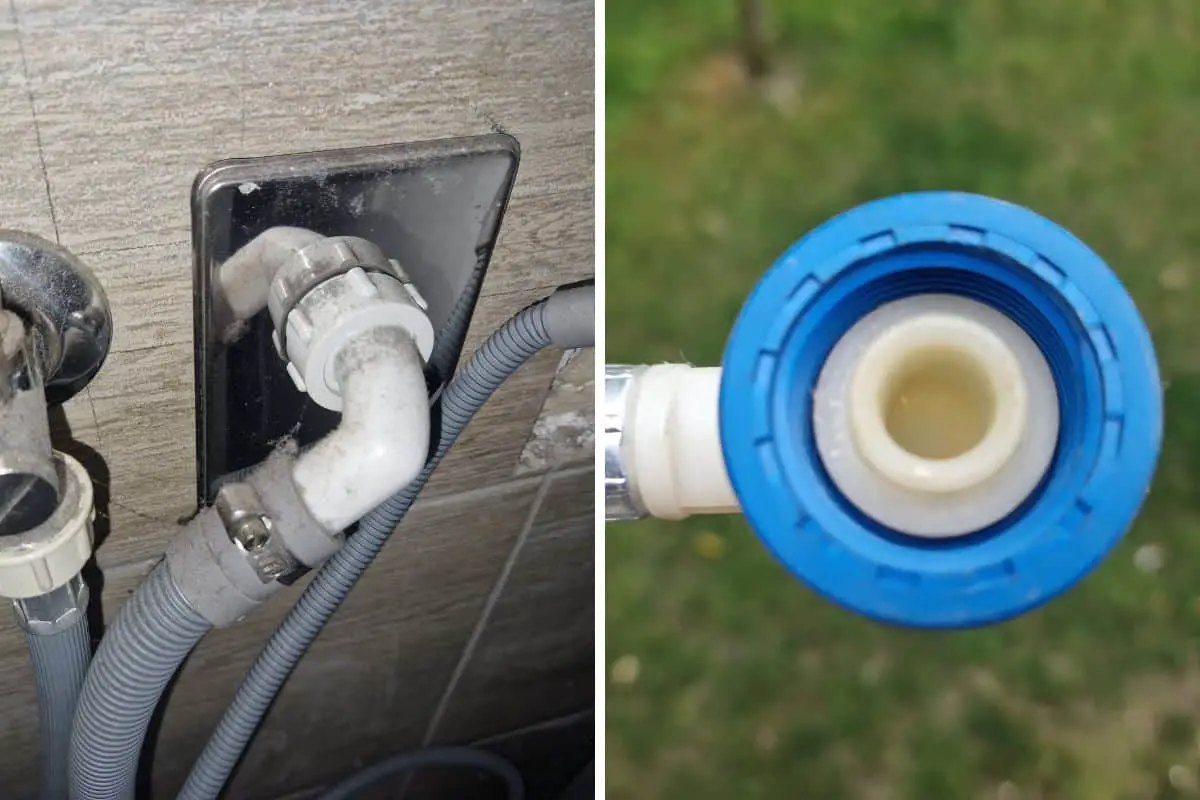If your washing machine drain smells like sewage, it’s probably because of a clog in the drain pipe. A clog can be caused by a build-up of detergent, lint, hair, or other debris. If you have a front-loading washing machine, the clog may also be caused by a build-up of mold and mildew.
A build-up of organic matter in the drain pipe can happen over time as laundry detergent, dirt, and other debris accumulate. Fortunately, there are a few things you can do to clean out the drain and eliminate the bad smell.
First, locate your washing machine drain. It is usually located near the back of the machine, underneath the tub. Once you have found it, use a plunger to try and dislodge any debris that may be causing the blockage. If this doesn’t work, you can try using a plumber’s snake or a drain auger to clear the drain.
If you still have a sewage smell coming from your washing machine drain, it is likely because there is a build-up of bacteria in the drain. To clean this out, mix a solution of 1 part bleach and 10 parts water. Pour this down the drain and let it sit for several hours before flushing with hot water. Repeat this process once a week to prevent the build-up of bacteria and to keep your washing machine drain smelling fresh.
If neither of those solutions works, another way to clean a washing machine drain that smells like sewage, you’ll need to remove the clog and then disinfect the drain pipe.
1. Start by removing any laundry detergent build-up from the rim of the washing machine tub. Use a damp cloth to wipe away any detergent residue.
If your washing machine drain smells like sewage, it is probably due to a build-up of laundry detergent on the rim of the tub. To remove this build-up, first, fill the tub with hot water and then add 1 cup of white vinegar. Let the mixture sit for 30 minutes before draining it out. Next, scrub the rim of the tub with a soft brush to remove any remaining detergent build-up. Finally, rinse the tub with clean water to remove any vinegar residue.
2. Next, you’ll need to remove the clog from the drain pipe. If you can reach the clog with your hand, you can try to break it up and remove it that way. If the clog is out of reach, you’ll need to use a plunger or a plumber’s snake.
A plumber’s snake is a tool used to clear clogs in drains. It consists of a long, flexible metal rod with a spiral of barbed wire at the end. To use it, you insert the rod into the drain and twist it to work the wire through the clog. There are a few places where you can purchase a plumber’s snake, such as hardware stores or home improvement stores. You may also be able to find them online.
First, make sure that the washing machine is turned off and unplugged. Then, place the plunger over the drain and plunge up and down until the clog is dislodged. You may also need to use a plumber’s snake to reach the clog if it is further down the drain pipe. Insert the snake into the drain and turn it clockwise until you feel resistance. Continue turning until the clog is removed.
3. Once the clog is removed, flush the drain pipe with hot water to remove any lingering debris.
The main reason you would want to flush a laundry machine drain pipe with hot water is to remove any lingering debris that may be present. Hot water is generally more effective at breaking down and removing small pieces of debris than cold water, so flushing the pipe with hot water can help to ensure that all debris is removed.
Additionally, hot water can help to kill any bacteria or other organisms that may be present in the pipe, which can further improve the cleanliness of your laundry machine.
4. Finally, disinfect the drain pipe by pouring a cup of bleach down the drain. Let the bleach sit for a few minutes before flushing with hot water again.
The main reason to disinfect a laundry machine drain pipe after clearing out a clog is to prevent the growth of mold and mildew. Both of these can cause serious health problems, so it’s important to keep your drains clean and free of any potential contaminants. Additionally, regularly cleaning and disinfecting your laundry machine’s drain pipe will help to extend its lifespan.
How come my washing machine drain smells like sewage?
When your washing machine drain smells like sewage, it is not only unpleasant but can also be a sign of a serious problem. If you notice this issue, you should take action to clean the drain and prevent the problem from returning.
If your washing machine drain smells like sewage, there could be a couple of different things happening.
- First, if there is an issue with the P-trap, it could cause a sewage smell.
A P-trap is a type of plumbing fixture that is used to prevent sewer gases and odors from entering your home through the drains. It works by trapping a small amount of water in the “P” shaped portion of the fixture, which acts as a barrier to block sewer gases from passing through.
P-traps are required by code in most areas and are a simple and effective way to keep your home’s drains smelling fresh and clean. P-traps can become clogged for a variety of reasons. The most common reason is that people try to flush things down the drain that shouldn’t be flushed, such as diapers, paper towels, or feminine hygiene products.
Another common reason is that grease and hair can build up over time and eventually cause a blockage. If you think your p-trap is clogged, the best thing to do is call a plumber.
- If the washing machine is not draining properly, this could also lead to a sewage smell.
If the washing machine is not draining properly, there are a few things that you can check. First, make sure that the drain hose is not kinked or blocked. Also, check to see if the pump is working properly. If neither of these is the problem, then it may be an issue with the drainage system itself.
- Additionally, if something is blocking the drainage pipe, it could create a backup and result in a sewage smell.
Most laundry machine drainage pipes have a diameter of at least 1 inch (2.5 cm). When installed, the pipe should be sloped so that it drains properly, and should be installed by a qualified professional.
One common cause of a blocked drainage pipe is when tree roots grow into the pipe and block the flow of water. Another cause can be when there is a build-up of debris, such as leaves or dirt, that gets caught in the pipe and prevents water from flowing through. If you have a blocked drainage pipe, it is important to clear it as soon as possible to avoid flooding or water damage.
Why the washing machine smells worse after cleaning
If your washing machine smells worse after cleaning, it could be due to several different factors.
- First, if you are using a home remedy to clean the machine, it is possible that the ingredients you are using are not fully effective.
- Second, if you have not properly cleaned the machine in the past, there could be a build-up of mildew or mold that is causing the smell.
- Third, if you have not properly ventilated the room where the machine is located, this could also be a contributing factor.
- Lastly, if there are any leaks in the machine, this could also lead to a musty or mildewed smell.

